To cope with SAD at home, maximize natural light by opening curtains and spending time near windows each morning. Use full-spectrum light therapy devices safely, positioning them properly and scheduling sessions early in the day. Establish a consistent routine with regular sleep and meal times, stay active outdoors whenever possible, and eat a balanced diet rich in omega-3s and complex carbs. Creating a cozy, stress-reducing environment can boost your mood—continue to explore ways to manage symptoms effectively.
Key Takeaways
- Maximize natural light indoors by opening curtains early and arranging furniture near windows.
- Use bright light therapy devices with at least 10,000 lux in the morning to boost mood and regulate your circadian rhythm.
- Establish a consistent daily routine with regular sleep, wake times, and morning light exposure to stabilize mood.
- Engage in regular outdoor physical activity to increase sunlight exposure and improve mental well-being.
- Maintain a balanced diet rich in omega-3s, complex carbs, and fruits and vegetables to support mood and energy levels.
Understanding What Causes Seasonal Affective Disorder

Understanding what causes Seasonal Affective Disorder (SAD) can help you better manage its symptoms. Seasonal changes, especially during fall and winter, play a significant role. Reduced daylight disrupts your body’s internal clock, affecting your sleep and alertness. This disruption can lead to emotional symptoms like feelings of sadness, hopelessness, or irritability. You might also notice a loss of interest in activities you usually enjoy, coupled with low energy and fatigue. These emotional symptoms often intensify as days get shorter. Your body’s response to the lack of sunlight influences hormone levels, such as serotonin and melatonin, which regulate mood and sleep. Recognizing this connection helps you understand why these changes happen and highlights the importance of addressing light exposure to manage SAD effectively. Additionally, understanding the role of light therapy as a self-sufficiency technique can be beneficial in offsetting the effects of reduced sunlight. Incorporating sound design techniques, like calming ambient sounds, can also support mood regulation during darker months. Furthermore, engaging in emotional support activities can provide comfort and resilience during these challenging times.
Maximizing Natural Light in Your Space
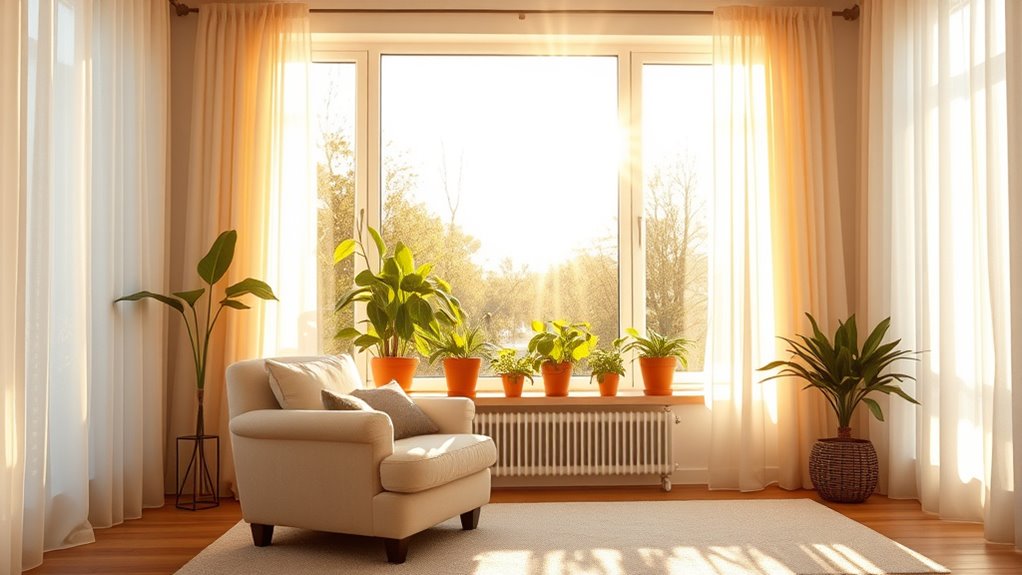
Maximizing natural light in your space is a simple yet effective way to combat the symptoms of Seasonal Affective Disorder. To do this, start by opening curtains and blinds each morning to let sunlight flood in. Use light-colored window treatments that reflect rather than block light, and consider removing heavy drapes during the day. Incorporate indoor plants near windows; they thrive in natural light and help boost your mood. Additionally, arrange furniture to avoid blocking windows, ensuring maximum sunlight reaches your living areas. Finally, clean windows regularly to maximize clarity and light penetration. These small adjustments can markedly improve your exposure to natural light, helping you feel more energized and aligned with the seasons. Be mindful of light exposure and how it influences your mood and well-being. Regularly using an air purifier can also help improve indoor air quality, creating a healthier environment that supports overall well-being during darker months. Incorporating natural light strategies can further enhance your mood and reduce symptoms of Seasonal Affective Disorder. Moreover, choosing appropriate window treatments can control glare and optimize light without sacrificing privacy. Remember that optimal lighting is essential for maintaining a positive mood and emotional health during the winter months.
Incorporating Bright Light Therapy at Home
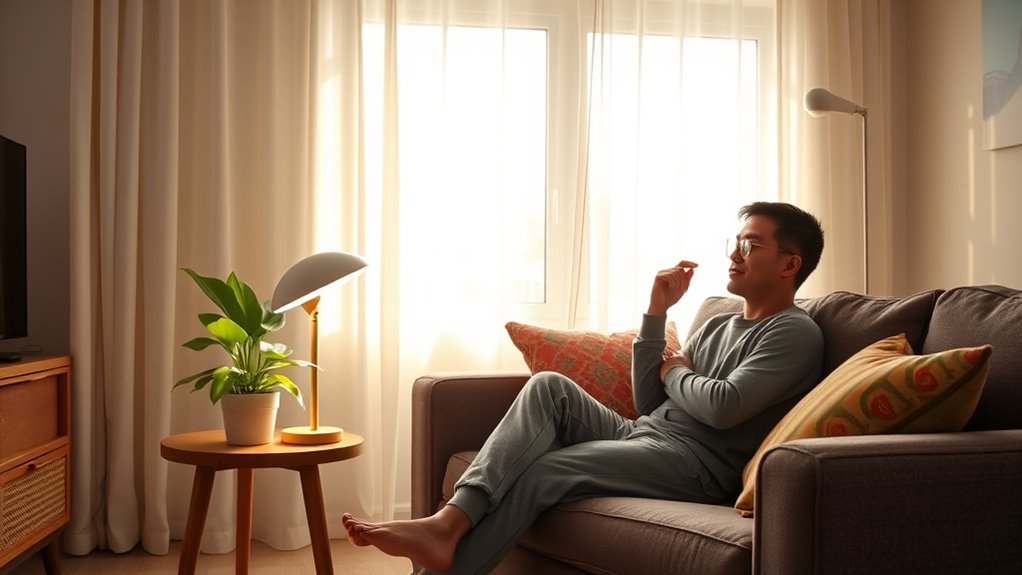
When adding bright light therapy to your routine, choosing the right light is essential for effectiveness and safety. You’ll also want to contemplate the best time of day to use it and follow safety precautions to avoid side effects. Let’s explore how to select, use, and stay safe with your at-home light therapy. Additionally, understanding the importance of proper Gold IRA Rollovers can help you diversify your retirement portfolio and protect your savings against economic uncertainties. Selecting a device with an appropriate headphone jack ensures compatibility and optimal audio quality during your therapy sessions, especially if you prefer listening to calming sounds or guided meditation through headphones.
Choosing the Right Light
Choosing the right light is essential for effective bright light therapy at home. You want a light that mimics natural sunlight, so pay attention to the light spectrum. A full-spectrum bulb guarantees you’re receiving a broad range of wavelengths, which can help regulate your circadian rhythm. Also, consider bulb brightness; a minimum of 10,000 lux is recommended for therapeutic benefits. Here are some key points:
- Opt for a light with a broad light spectrum that includes blue light.
- Guarantee the lamp provides at least 10,000 lux at a comfortable distance.
- Check that the bulb’s spectrum closely resembles natural sunlight.
- Choose a design that minimizes glare and is easy to position.
- Incorporate automation technologies to ensure consistent daily use and optimal timing of your therapy sessions. Utilizing light diffusers can help distribute light more evenly and reduce harsh glare, enhancing comfort during therapy. Implementing smart lighting controls can further optimize your therapy routine by adjusting brightness and timing automatically based on your schedule. In addition, selecting lights with adjustable intensity can help tailor the therapy sessions to your comfort level, making the treatment more effective. Properly integrating these lighting features can improve both the effectiveness and comfort of your therapy sessions. Selecting the right setup can make your therapy more effective and comfortable.
Optimal Usage Timing
To get the most benefit from bright light therapy, timing your sessions correctly is essential. Ideally, you should use the light in the morning shortly after waking, as this helps regulate your circadian rhythm and boosts mood throughout the day. Proper light placement is key—position the lamp at eye level, about 16 to 24 inches away, so the light reaches your eyes without causing discomfort. Make sure the bulb brightness is sufficient, typically between 10,000 lux, to ensure effectiveness. Consistency matters, so try to stick to a regular schedule each morning. Avoid using the light late in the day, as it can interfere with your sleep patterns. Additionally, understanding the importance of light intensity can help you choose the right therapy equipment for optimal results. Using data-driven strategies can guide you in selecting the most effective device for your needs. Paying attention to light placement can enhance the therapy’s effectiveness and comfort. Maintaining good air quality in your environment can also support your overall well-being during treatment. By timing your sessions well, you maximize the therapy’s positive impact on your seasonal affective disorder symptoms.
Safety and Precautions
While bright light therapy can be highly effective for managing seasonal affective disorder at home, it’s important to prioritize safety to avoid potential side effects. To guarantee safe use, follow these precautions:
- Always use a light box certified for safety and effectiveness to prevent light bulb safety issues.
- Position the light at the correct distance and angle, typically about 16-24 inches away, to protect your eyes and skin.
- Limit exposure time initially and gradually increase to avoid eye strain or headaches.
- Maintain a safe environment by avoiding direct eye contact with the light source and consulting your healthcare provider if you experience discomfort.
Prioritizing home safety helps maximize benefits while minimizing risks during light therapy.
Establishing a Consistent Daily Routine
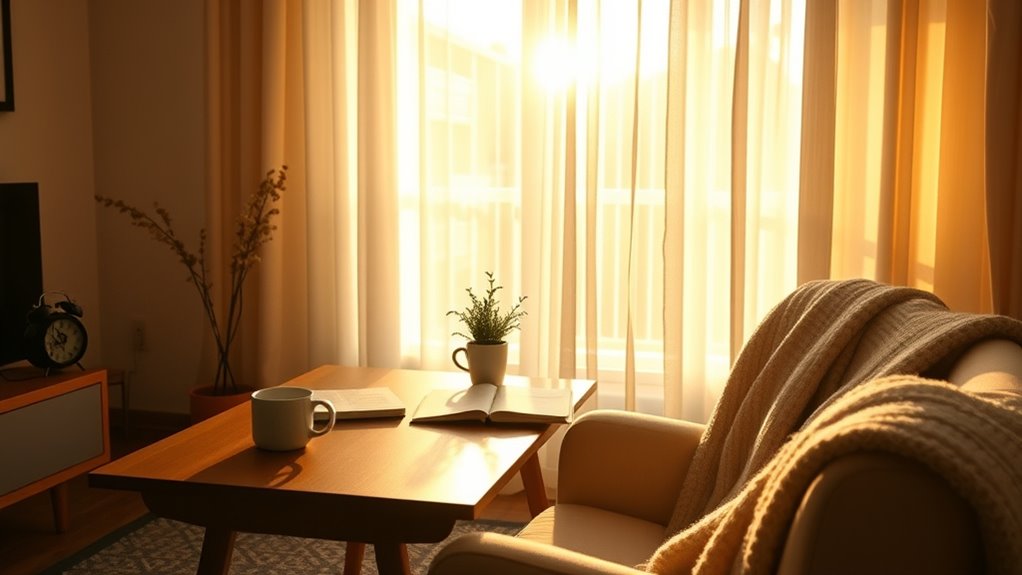
Creating a consistent daily routine can help stabilize your mood and energy levels. You should aim to wake up at the same time each day and get morning sunlight whenever possible. Maintaining a regular sleep schedule guarantees your body stays in sync and reduces feelings of fatigue. Incorporating security features like password management and session control can also help protect your personal information during your daily routine.
Set Regular Wake Times
Establishing a regular wake time is essential for managing Seasonal Affective Disorder because it helps regulate your body’s internal clock. Consistency in your wake-up schedule improves energy levels and mood. To support this, consider these tips:
- Set an alarm for the same time daily, even on weekends, to reinforce your routine.
- Use meditation techniques in the morning to start your day calmly and focus your mind.
- Arrange your home decor tips to create a peaceful, clutter-free space that signals relaxation and readiness for the day.
- Avoid hitting snooze repeatedly—getting up at the same time stabilizes your circadian rhythm and can lessen symptoms over time.
- Incorporate light exposure early in the day, such as opening curtains or using a lightbox, to help synchronize your internal clock with natural daylight.
Sticking to a sleep schedule creates stability, making it easier to manage SAD symptoms effectively.
Prioritize Morning Light
Getting morning sunlight is a powerful way to boost your mood and regulate your body’s internal clock. Prioritizing light exposure early in the day can improve your energy and lessen SAD symptoms. Incorporate morning routines that include spending time outdoors or near a window. Consistent light exposure helps stabilize your circadian rhythm, making it easier to wake up and feel alert. Additionally, understanding the science of circadian rhythms can help you optimize your light exposure for better mood regulation.
Maintain Consistent Sleep Schedule
Maintaining a consistent sleep schedule is essential for managing Seasonal Affective Disorder because it helps regulate your body’s internal clock and improves overall mood. Good sleep hygiene guarantees you go to bed and wake up at the same times daily, reinforcing your circadian rhythm. To strengthen your routine, consider these steps:
- Set a fixed bedtime and wake-up time, even on weekends.
- Limit screen time before bed to enhance sleep quality.
- Create a relaxing pre-sleep routine, like gentle stretching or reading.
- Use dream analysis to identify stressors or emotional patterns affecting your sleep.
Sticking to this routine helps stabilize your mood, reduces fatigue, and supports mental clarity. Consistency in sleep hygiene ultimately fosters better rest and emotional resilience during darker months.
Prioritizing Physical Activity and Movement

When managing seasonal affective disorder, prioritizing physical activity and movement can make a significant difference. Regular exercise routines boost your mood by releasing endorphins, helping you feel more energized and less sluggish. Incorporate outdoor activities like walking, jogging, or cycling to maximize sunlight exposure, which can improve your overall well-being. Even a short daily walk outside can lift your spirits and combat feelings of gloom. Staying active also helps regulate your sleep patterns and reduces stress. It’s important to find activities you enjoy so you stay motivated. By making movement a priority, you create a positive feedback loop that supports your mental health during darker months. Remember, consistency is key—small steps can lead to meaningful improvements.
Maintaining a Nutritious and Balanced Diet

Incorporating nutritious and balanced foods into your daily routine can substantially enhance your mood and energy levels during darker months. Proper nutritional planning helps guarantee you get essential nutrients that support mental health. Focus on consistent meal timing to maintain stable blood sugar levels, preventing energy dips. To optimize your diet, consider these strategies:
- Prioritize foods rich in omega-3 fatty acids, like salmon and walnuts.
- Include complex carbohydrates such as whole grains and legumes to boost serotonin production.
- Incorporate plenty of fruits and vegetables for vitamins and antioxidants.
- Avoid skipping meals, especially breakfast, to sustain your energy throughout the day.
Cultivating Mindfulness and Stress Reduction Techniques
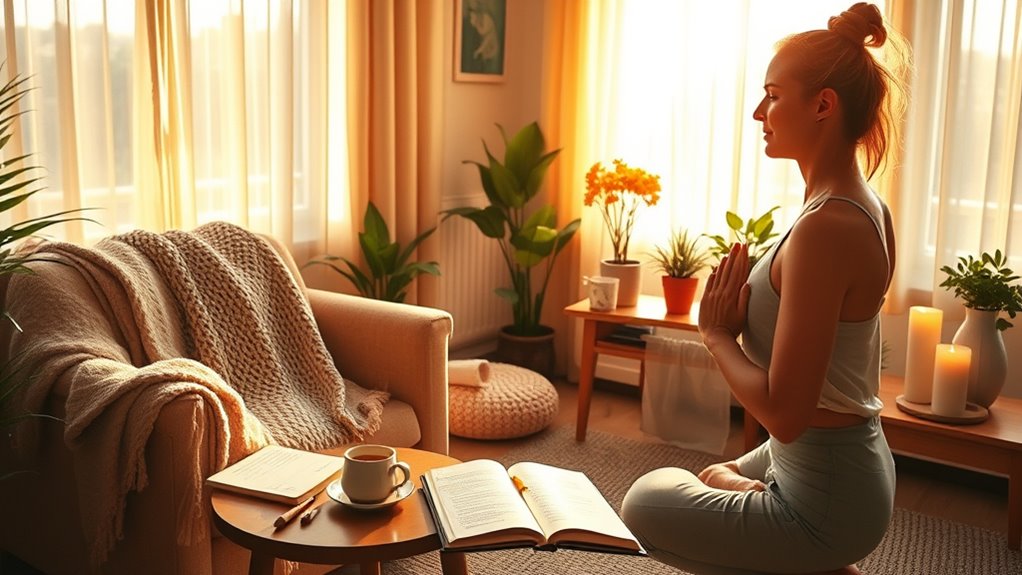
Practicing mindfulness and stress reduction techniques can considerably improve your resilience during the darker months. Engaging in mindfulness meditation helps you stay present, reducing feelings of anxiety or gloom associated with seasonal affective disorder. By dedicating a few minutes daily to focused breathing or body scans, you develop better stress management skills, which can alleviate emotional lows. These techniques encourage you to observe your thoughts without judgment, fostering a calmer mindset. Incorporating mindfulness into your routine can also increase your awareness of negative thought patterns, allowing you to shift your perspective. Overall, consistent practice of mindfulness meditation and stress management strategies equips you with practical tools to combat seasonal mood changes and maintain emotional balance at home.
Creating a Cozy and Inviting Environment

Creating a cozy and inviting environment can substantially enhance your mood during the darker months. To boost mood enhancement, focus on how your space feels.
- Use seasonal lighting, like warm-colored bulbs or string lights, to mimic sunlight and lift your spirits.
- Add soft textiles, such as plush blankets and cushions, to create comfort and warmth.
- Incorporate natural elements like plants or wooden accents to evoke a sense of calm.
- Keep your space tidy and clutter-free, which helps reduce stress and promotes relaxation.
When to Seek Professional Support
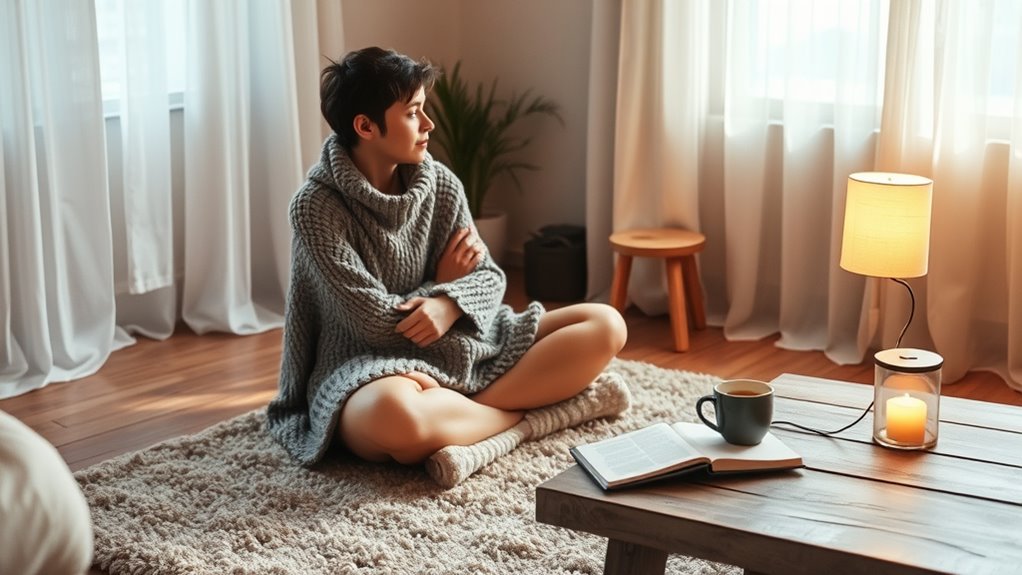
Recognizing when to seek professional support is essential if your symptoms of seasonal affective disorder persist or worsen despite self-care efforts. If you notice ongoing feelings of sadness, fatigue, or loss of interest that interfere with your daily life, it’s time to consult a mental health professional. They can discuss therapy options like cognitive-behavioral therapy (CBT), which helps change negative thought patterns, or light therapy recommendations. Medication considerations might also be necessary if symptoms are severe or resistant to other treatments. Don’t hesitate to reach out for help; professional support can provide personalized strategies and medication management to alleviate your symptoms and improve your well-being during challenging seasons. Early intervention is key to feeling better.
Frequently Asked Questions
Can Natural Remedies Effectively Treat Seasonal Affective Disorder at Home?
Natural remedies can help manage seasonal affective disorder at home, but their effectiveness varies. Light therapy is a popular option, as exposing yourself to bright light mimics sunlight and boosts mood. Herbal supplements like St. John’s Wort or SAMe may also provide relief, though you should consult your doctor first. Combining these remedies with healthy habits can improve your overall well-being during darker months.
How Do I Monitor My Mood Changes Throughout the Season?
To monitor your mood changes throughout the season, you can start with mood journaling by writing daily about how you feel. Additionally, use mood tracking apps that allow you to log your emotions regularly. These tools help you identify patterns and triggers, making it easier to recognize worsening symptoms early. Consistent tracking empowers you to take proactive steps and share accurate information with your healthcare provider.
Are There Specific Indoor Plants That Help Improve Mood?
You’re wondering if certain indoor plants can boost your mood. Many indoor plant benefits include improving air quality and adding mood-boosting foliage to your space. Plants like lavender, snake plants, and pothos are known for their calming effects and vibrant greenery. Incorporating these into your home can create a more uplifting environment, helping to lift your spirits and reduce feelings of seasonal gloom.
What Are Quick Stress Relief Techniques for Seasonal Mood Dips?
Did you know that practicing mindfulness exercises can reduce stress by up to 40%? When mood dips, try quick breathing techniques like deep inhales through your nose and slow exhales to calm your mind. These easy, effective strategies help you regain focus and relax immediately. Incorporate short mindfulness exercises into your day to lift your spirits and manage seasonal mood dips more effectively.
How Can Family Members Support Someone With SAD at Home?
You can support someone feeling sad at home by practicing supportive communication, actively listening, and offering reassurance. Encourage them to engage in activities they enjoy, which can boost their mood. Show empathy and patience, letting them know you’re there for them without pushing. Your consistent support and positive reinforcement help create a safe space, making it easier for them to navigate their feelings and find moments of relief.
Conclusion
So, now that you’re armed with these home hacks, you’re practically a seasonal affective disorder superhero—minus the cape, of course. Remember, while pretending your living room is a sun-drenched paradise and doing yoga in pajamas might work wonders, it’s okay to admit when you need professional help. After all, even superheroes have sidekicks. Keep shining, stay balanced, and don’t forget: brighter days are just a few cozy steps away.










